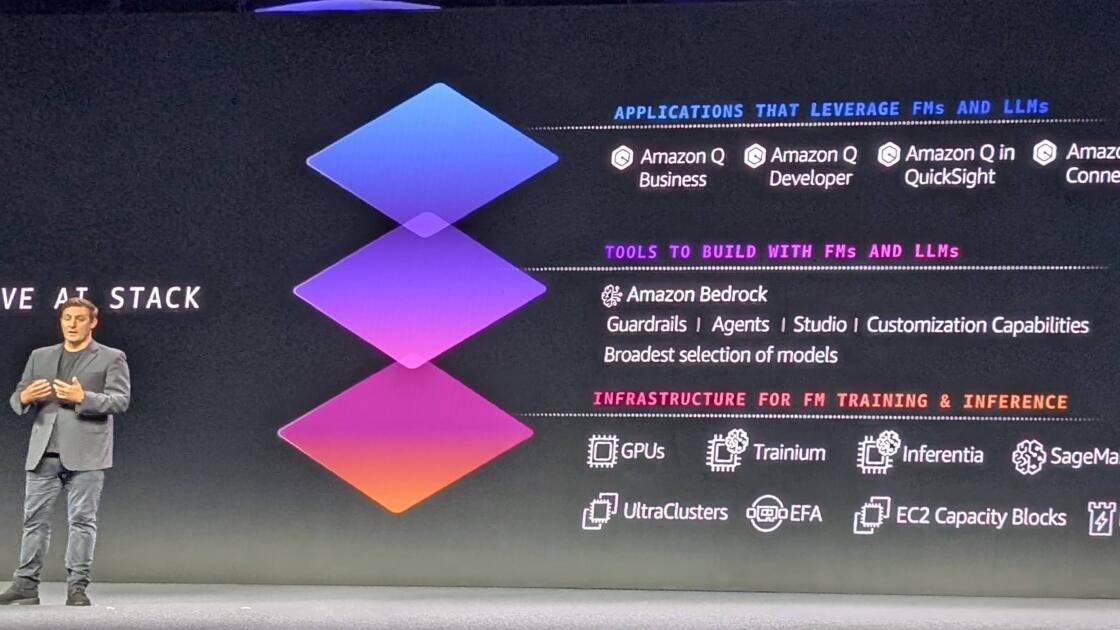
As I attended the Amazon Web Services (AWS) Summit in New York last week, I was struck by how much of the presentation focused on security. While the big news was the introduction of AWS App Studio, an AI-based (prompt-based) low-code app builder, much of the conversation dealt with making people comfortable with the results they get from generative AI.”There is a schism in some customers’ minds that, in order to be successful with generative AI, you have to make some sort of negative trade-off when it comes to the confidentiality, privacy, and security of your data,” AWS VP for AI Products Matt Wood said during his keynote. But he went on to say that AWS doesn’t use data from the services to improve its underlying models and doesn’t have humans reviewing any of the information inside a customer’s virtual environment. (Of course, AWS’s competitors will say pretty much the same thing.)In general, firms in regulated industries are moving faster on Gen AI than others, Wood said, because they already have the compliance in place.AWS has introduced 326 generative features since 2023, which Wood said is twice that of the other major cloud vendors combined. Again, some of this is a matter of counting, as AWS tends to offer smaller individual services, while its competitors often combine some of those things into larger services. But there’s no question that all of the providers are focusing on AI these days. Indeed, Amazon didn’t announce anything that wasn’t AI at the summit.Wood talked about having the largest number of models available on AWS because organizations want to mix and match models to handle a diverse set of use cases. He also talked about how AWS offers a wide variety of hardware including Nvidia GPUs and Amazon’s own Graviton, Inferentia, and Trainium chips. And of course, he talked about AWS’s development tools, including SageMaker. The Amazon Q assistant is now available in SageMaker Studio, which he said offers “a step function change in ease of use.”But most of his keynote focused on using models more safely, taking foundation models and making them more closely align to your needs. The methods he described—fine-tuning, retrieval-augmented generation (RAG) to specialize and personalize results and guardrails—are the same as we’ve heard from others, but he introduced several important new features in all those areas.For fine-tuning, he announced that the models from Anthropic will be available for fine-tuning on AWS, starting with Claude 3 Haiku, which is meant to be the fastest and most cost-effective model. (Interestingly, Amazon’s own Titan models were barely mentioned.)RAG has been improved with Knowledge Bases for Amazon Bedrock, including connectors for Salesforce, Confluence, SharePoint, etc. And he announced improved Guardrails, both for Bedrock (with contextual grounding checks) and as an API for use in AI applications in SageMaker or EC2 virtual machines.
Recommended by Our Editors
Most of the industry is pushing the concept of Agents—tools that actually perform tasks for you, and AWS is no exception. The company talked about adding to Agents within its Bedrock AI development platform, including memory retention so it can learn from interactions over time and code interpretation for Agents. Wood also talked about making Q Apps generally available, with lots of connectors to other applications and now with an API. For Q for developers, new features include developer customization, which now can understand your internal code base and how it works.The biggest new thing is AWS App Studio, in which you create an application starting with a prompt such as “build an expense account approval application.” As demonstrated, you begin by entering a prompt describing the application, then edit it in a visual builder, where you can drag and drop to edit or expand the application and which contains connectors to a variety of applications. So, for instance, you can notify an employee via Slack when the status of the approval changes. This is currently in preview in the US West region and is free to use, although, of course, the resulting applications run in AWS, where you pay the usual fees. It looked quite interesting.Overall, the introductions at the summit showed many movements in the same areas most of the AI community is working on. The concepts weren’t particularly new, but the implementations look quite useful.
Get Our Best Stories!
Sign up for What’s New Now to get our top stories delivered to your inbox every morning.
This newsletter may contain advertising, deals, or affiliate links. Subscribing to a newsletter indicates your consent to our Terms of Use and Privacy Policy. You may unsubscribe from the newsletters at any time.






